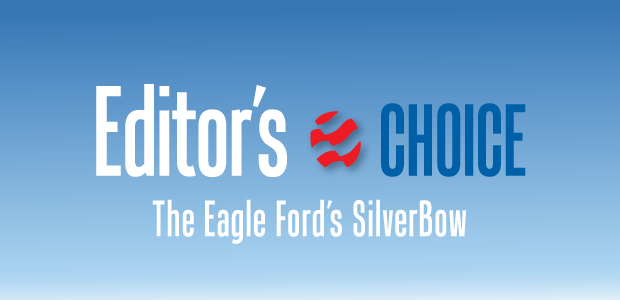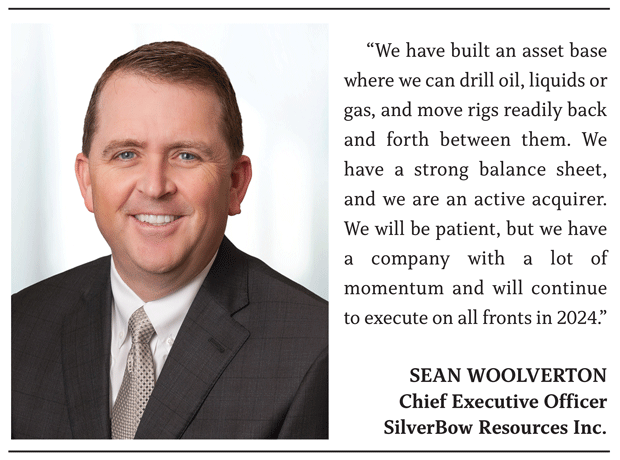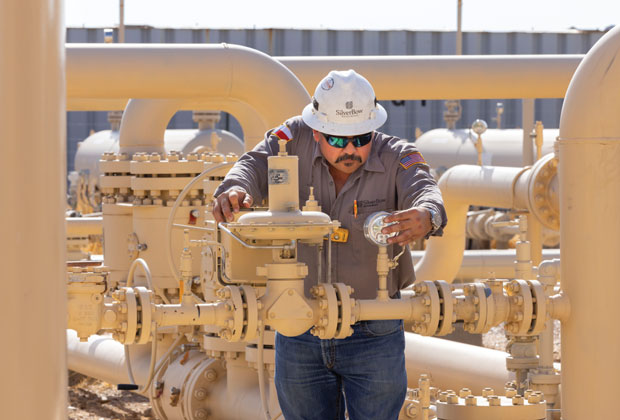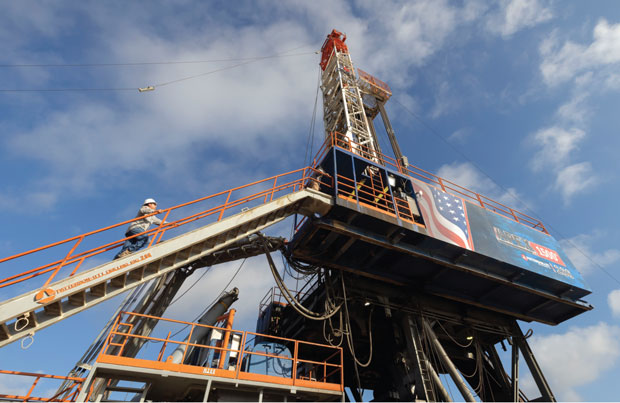
Acquisitions Fuel Growth, Diversified Production Mix For SilverBow In South Texas
By Danny Boyd
HOUSTON–In the era of the consolidated pure basin player, a diversified asset portfolio has taken on a new meaning. For many oil and gas operators, achieving such a portfolio principally implies having the operational flexibility to succeed through cycles, even if a company’s entire asset base is contained within a strategic basin or region. Not to oversimplify complex geology, but the Eagle Ford’s depth-related crude oil, wet gas and dry gas windows offer opportunities across all three hydrocarbon phases to help offset commodity price risk. Add in the Austin Chalk just above the Eagle Ford, and it takes portfolio diversity to a whole new level.
Sometimes oil and gas prices move in sync, but often they exhibit opposite behaviors, with one trending up as the other declines. Having near equal production of both liquids and natural gas, and the ability to focus development on the highest-returning assets, can provide steady returns as market conditions shift or seasonal factors swing prices. Having a diverse mixture of liquids and gas production in the same basin with peer-leading scales of operational efficiency helps even more. That summarizes SilverBow Resources Inc.’s advantaged position in the Eagle Ford.
Already the largest pure-play producer in the play—and the fourth largest overall in South Texas—the company continues to aggressively expand its footprint, build even more scale, diversify its production, and grow financial returns.
During 2024, Chief Executive Officer Sean Woolverton says Houston-based SilverBow will continue to look for additional growth opportunities after adding 172,000 net acres since 2021. At the same time, it will continue to march toward its goal of a 50/50 gas-to-liquids production mix, balancing what is now a 60/40 split favoring gas.
“In late 2018, we were probably 85% natural gas in terms of production, so getting a 50/50 balance for a gas-to-liquids mix was a pretty aggressive goal,” Woolverton says.
Woolverton adds that the benefits to achieving an equally balanced production mix are obvious, given recent commodity price patterns. Combined sales from oil and natural gas liquids were almost 2.5 times higher than for dry gas for the first three quarters of 2023 on a gas-weighted reserve base, he notes.
On The Rise
Formerly operated as Swift Energy until it was rebranded after emerging from Chapter 11 in 2016, SilverBow has amassed 1,000 drilling locations across South Texas. Its 220,000 net-acre footprint is about 25% larger than it had been in 2022. Woolverton reports that the company currently is running three rigs, up from two from last year, with each rig expected to drill 25-30 locations this year.
In 2024, SilverBow projects that its output will increase by 30% to around 600 million cubic feet equivalent a day, Woolverton says. That is almost triple the second quarter of 2021, just prior to SilverBow closing on a series of Eagle Ford property acquisitions. Expected oil production of 25,000 barrels a day would triple 2022 oil output as the company amalgamates 42,000 liquids-rich acres acquired from Chesapeake Energy last November.
Along with 32,000 barrels of oil equivalent a day of oil, gas and NGLs (NGLs track the West Texas Intermediate index rather than Henry Hub dry gas prices), the Chesapeake transaction adds 200 “high-return” locations in the Austin Chalk and 100 in the Eagle Ford Shale in Texas’ Dimmit and Webb counties along the Mexico border. These projects already are competing internally for capital, Woolverton says, as the company involves field personnel in running the asset, tweaks production, streamlines operating costs and takes advantage of low-hanging fruit.
“The Chesapeake acquisition was our biggest to date. Prior to that, our last acquisition was in fourth quarter in 2022, so it had been almost a full year,” he recalls. “It marked the eighth transaction that we have closed over the past 24 months, and the deal checked all the boxes for us and made a lot of sense. It increased our liquids production and added a lot of high-quality inventory. We are looking forward to unlocking a lot of that value this year.”
According to Woolverton, about half of SilverBow’s $550-$580 million 2024 capital budget will be spent in the Austin Chalk. The chalk immediately overlies the Eagle Ford in portions of a region with multiple benches across 26 Texas counties extending from the Rio Grande in the southwest to just south of Dallas in the east.
Historically, horizontal drilling in the Austin Chalk preceded commercial success in the Eagle Ford Shale by several years, but the first unconventional commercial well in the Eagle Ford in 2008 changed the game in South Texas. As horizontal drilling and hydraulic fracturing approaches were perfected for Eagle Ford wells, operators began looking back at the Chalk and the potential for applying the same techniques.
Development activity focused on both the Austin Chalk and the Eagle Ford in the western portion of the play is today helping increase production across the basin, which is now close to 1.2 million barrels of oil and 7 billion cubic feet of gas a day.
In The Thick
SilverBow’s first Austin Chalk well, drilled in the dry gas Dorado play in southern Webb County in January 2021, is still among the best in its portfolio and was followed by about 20 others, Woolverton reviews. This year, the company will leverage its Austin Chalk expertise updip to maximize success in the liquids window to the north. He says the western Austin Chalk, along with the Eagle Ford Shale in Webb County, includes some of the thickest pays in the entire basin, which trends from shallower oil and liquids in the north to deeper dry gas zones farther south.
Through a series of acquisitions, highlighted by a late-year deal to acquire high-quality Austin Chalk and Eagle Ford properties from Chesapeake, Houston-based SilverBow Resources has grown into one of the largest producers in South Texas. It says it expects to increase production by a double-digit percentage this year while working toward achieving a 50/50 balance in its daily oil and gas output mix.
The company has drilled both Upper and Lower Eagle Ford wells, and Woolverton says SilverBow plans to similarly target both upper and lower intervals in the Austin Chalk.
“That is going to evolve in both the liquids northern portion of the play and in the southern gas portion,” Woolverton assesses. “We will probably drill mainly in the Lower Austin Chalk but will target some—the nomenclature is still evolving—Middle and Upper Austin Chalk as well.”
The acreage from Chesapeake includes big, blocky positions that allow for longer laterals. Across the region, lengths vary widely depending on lease configurations, Woolverton notes, with a typical target length from 7,500 to 8,500 feet, although laterals have extended to 14,000 feet in some cases.
“I do not think you are going to see in the Eagle Ford lateral lengths like in some of the other basins, where they may hit 20,000 feet,” he surmises. “The lease configurations do not allow for it.”
Vertical separation on the Dimmit-Webb position can be 200-300 feet between the Austin Chalk and the Eagle Ford, depending on the targeted bench, Woolverton points out. Total vertical depth ranges from 6,500 to 8,000 feet in the northern part of the area to 12,000 feet in gassy areas to the south.
Frac designs across the region are similar, he says, and SilverBow has condensed cluster spacings for better results. Some early wells were completed on 50-70 foot cluster spacings, which has since tightened to about 15 feet in each layer.
One frac crew is following the rigs, typically completing Austin Chalk wells with 2,000 pounds of sand and 40 barrels of water per lateral foot compared with 2,500 pounds and 50 barrels in the Eagle Ford.
“There is not a big difference between the zones, but there are slight differences,” Woolverton explains. “We attribute some of that to the chalk being a little bit better-quality reservoir. Neither has great permeability, but the chalk has better permeability than the Eagle Ford.”
Like other regional players, SilverBow continues to benefit from higher frac efficiencies. “When we were running one rig a couple of years ago, we were able to fully load a frac spread,” he recalls. “As we get into 2024 running three rigs, we will be able to keep that one frac spread fully loaded for the full year.”
Ramping Efficiency
Three years ago, the company averaged pumping about nine stages a day, but that has increased to 14 as SilverBow works with its contractors to identify ways to speed perforating and pumping down frac plugs. Overall completion operations are 80%-85% efficient as downtime diminishes, Woolverton notes.
“We really measure our completion efficiency around how many hours in the day the pumps are pumping,” he says. “We are seeing days now where we pump 80% of the time, where we are pumping 20 hours a day and minimizing down time,” he remarks.
Greater efficiency from scale and the same field leadership with the same stimulation and drilling contractors month after month are supporting the efficiency gains.
“Beyond that, we are seeing faster drilling penetration rates by optimizing our mud systems and bottom-hole-assemblies, and tearing into the subsurface by better understanding seismic and petrophysical data on where to land the lateral in target zone,” Woolverton says. “We are drilling faster, but we also have a tighter tolerance in terms of staying in zone. We are not just being more efficient at getting wells drilled faster; we are also getting higher-quality wells.”
Faster drilling and more stages pumped per day, along with some cost deflation effects and tight coordination among field personnel and technical teams, helped reduce 2023 capital expenses by 10%, he reports.
SilverBow is running three rigs and one frac spread in its South Texas acreage. The company is pumping an average of 14 stages a day, with 80%-85% efficiency in overall completion operations. That translates to pumping 20 hours a day on average on its active frac sites.
On the completion side, efficiencies are gained through a combination of factors from a logistics management standpoint, Woolverton says. The company often “debundles” completion services. Sand management, supplied by in-basin mines, is timed to ensure on-time delivery and avoid dead time waiting for sand supply.
Efficiencies, scale and production gains have helped generate free cash flow since 2020. This year, the company plans a sizeable jump as it optimizes total debt to earnings before interest, tax, depreciation and amortization. According to Woolverton, SilverBow exited 2023 with free cash flow of $40 million-$60 million and about $500 million in liquidity, which was doubled from $250 million at the end of the previous year.
“That gives us more firepower to enact our growth strategy going forward,” Woolverton says. “It gives us a lot of optionality.”
To protect against inevitable commodity price fluctuations, the company is cautious about long-term contracts and has hedged roughly two-thirds of its gas production for 2024 at ±$3.80/Mcf. More than 50% of its daily oil output is hedged at ±$70-$75/bbl.
Turning to safety and sustainability, Woolverton says he is proud of SilverBow’s strong performance on that front. The company published its first sustainability report in the spring and is ranked as one of the top places to work in Houston. The company closely collaborates with landowners to source subsurface water and install ponds. Disposal is done exclusively by third parties, and SilverBow continues to look for ways to reuse water, although it has not yet initiated a full commercial-scale project.
“But that is something that is always front and center as we strive to properly manage water from sourcing freshwater to disposing of produced water,” Woolverton says.
Looking For Opportunities
In the Eagle Ford, SilverBow will remain among the region’s suitors as it looks to add acreage, boost production and further diversify its product mix, according to Woolverton.
“The basin is still pretty fragmented, and there are probably a couple dozen or more private companies that have asset values ranging from 50 million to several billion dollars, so there is quite a bit of potential inventory there for merger and acquisition opportunities,” he says. “Not all of those companies are in the market, but will 2024 be a year in which some will look to monetize? Just like we have seen over the last couple of years, I am guessing the answer could be yes.”
Commodity price volatility can make it harder to reach agreeable asset prices, and bid-ask spreads can be a little wider, but Woolverton insists SilverBow has demonstrated that it can provide fair valuations and get to closing efficiently.
“We have built an asset base where we can drill oil, liquids or gas, and move rigs readily back and forth between them,” he says. “We have a strong balance sheet, and we are an active acquirer. We will be patient, but we have a company with a lot of momentum and will continue to execute on all fronts in 2024.”
The company has not refractured an Eagle Ford producing well, but anticipates conducting a refrac this year after studying the efforts of other South Texas players, he continues. SilverBow’s production portfolio includes about 1,500 wells, with many of them drilled and completed prior to 2016-17 when operators pumped significantly smaller sand and water volumes, and stages and cluster spacings were wider. As a result, the entire lateral in many cases was not effectively stimulated.
“Through all these acquisitions that we have done, we did not place any value on refracs,” Woolverton notes. “In fact, on most of the transactions, we were able to acquire the drilling inventory at no cost. One of things I really like about doing acquisitions right is that you always find more oil where oil has been found. I think refracs might be another opportunity for us on this asset base.”
Beyond production diversity, refrac potential and attractive prospects for both the Austin Chalk and Eagle Ford Shale, the region is attractive because of the availability of oil pipelines connecting to the Port of Corpus Christi and natural gas outlets to the growing Gulf Coast petrochemical and industrial complex, he says. Liquified natural gas terminals, including the upcoming Rio Grande LNG project in Brownsville, Tx., are close by.
Recent pipeline projects have doubled daily takeaway capacity from Webb County from 2 Bcf/d to 4 Bcf/d, which has alleviated constraints that arose after a couple of years of climbing rigs counts in the Eagle Ford and Austin Chalk trends. “These pipeline projects were completed by the end of 2023,” he says. “South Texas is just a more favorable part of the country to work in where infrastructure projects are supported and can get implemented within a short time.”
For other great articles about exploration, drilling, completions and production, subscribe to The American Oil & Gas Reporter and bookmark www.aogr.com.









